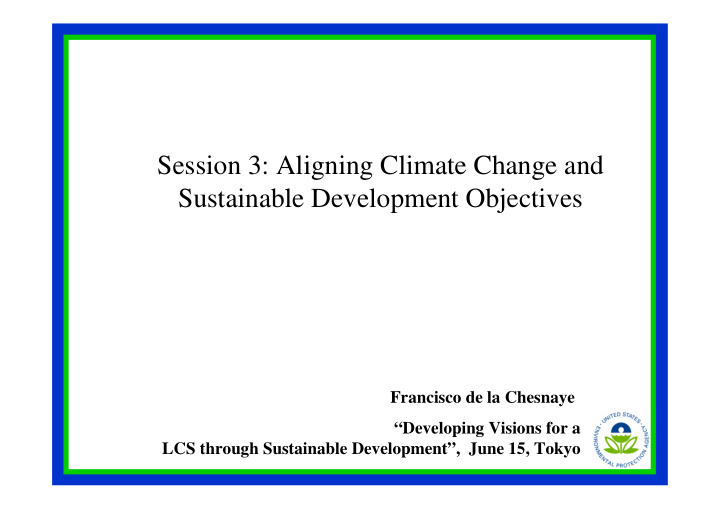



Session 3: Aligning Climate Change and Sustainable Development Objectives Francisco de la Chesnaye “Developing Visions for a LCS through Sustainable Development”, June 15, Tokyo
Some questions for discussion • What does “Low Carbon” mean, (lower carbon, lowest carbon, no carbon) in the context of development ? • What are we committed to over the next 30+ years in terms of: – Climate change (consider impacts, vulnerability and adaptation) – Current and near-term installed capacity, primarily in the power generation and transportation infrastructures, and resulting emissions – Other international policy priorities • What are win-win strategies across all these policies that also work at the local, national, and international levels
SD measures influencing emissions • Improve access to reliable and affordable energy services (stress on decentralised and renewable energy systems, modern biomass technologies, cleaner liquid and solid fuels, energy efficiency, etc.) • Changing unsustainable production and consumption patterns – Establish and support cleaner production programmes and centres – Incentives for investment in cleaner production and eco-efficency – Develop production and consumption policies… reducing environmental and health impacts… • Promote an integrated approach to policy making at the national, regional and local levels • Sectors that are most significant to both CC and SD as: Water, Energy, Health, Food, Ecosystems (Biodiversity and forestry), Human settlements, & Disaster preparedness Source: IPCC WG3, CCT on CC & SD by L. Srivastava and T. Heller
Low stabilization targets cut into land use related emissions 30 Non-CO2 - energy/industry CO2 - energy/industry 25 Non-CO2 - land CO2 - land 20 GtCO2-eq 15 650 ppm 10 550 ppm 5 450 ppm 0 2000 2020 2040 2060 2080 2100 Courtesy Tom Kram, MNP
62% Source: IEA, WEO 2004
Source: D. Hawkins, NRDC
What will Drive Energy (Development & Climate) Futures? 1. Economic Growth 2. Population 3. National/ Regional Circumstances • Energy Resource Endowment Energy Security, • Structure of Economy Adaptation, • National/Regional Governance Mitigation • Geopolitics 4. Global Governance • Trade Regime International • Mobility/Migration Policies • Climate Change Adapted from P.R. Shukla
Example of Multiple Policy Challenges: Expanding the use of modern liquid biofuels across the world • Links between biofuels and international commodities markets (eg ethanol x sugar, biodiesel x castor oil, palm oil, soybeans): effects of price subsidies, WTO rounds, large scale bioenergy programs on international prices of feedstocks and final products. Courtesy Emilio L. La Rovere
CO 2 Emissions in in Transportation Transportation CO 2 Emissions Sector Sector Courtesy Emilio L. La Rovere
Some questions for discussion • What does “Low Carbon” mean, (lower carbon, lowest carbon, no carbon) in the context of development ? • What are we committed to over the next 30+ years in terms of: – Climate change (consider impacts, vulnerability and adaptation) – Current and near-term installed capacity, primarily in the power generation and transportation infrastructures, and resultant emissions – Other international policy priorities • What are win-win strategies across all these policies that also work at the local, national, and international levels
Recommend
More recommend